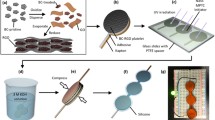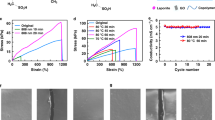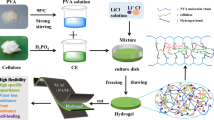Abstract
Electrolyte regeneration is an important goal for environmental protection and sustainable development efforts. Herein, we report a facile strategy inspired by the transformation of edible dough from flour to regenerate hydrogel electrolytes from their dehydrated copolymer granules (CGs) via direct addition of water or salt solution. With the aid of heating, this procedure is efficient, relatively quick, and easily implemented. The dehydrated CGs are lightweight, reusable and stable under long-term storage. Even after 5 cycles of dehydration and regeneration, the regeneration efficiency of the hydrogel electrolytes, as evaluated based on retention of mechanical strength, is over 60%. The regenerated electrolytes possess considerable ionic conductivity, reprocessability, and 3D-printability. Furthermore, an all-gel supercapacitor assembled from the regenerated hydrogel electrolyte and activated carbon electrode with CGs as binder demonstrates excellent interfacial compatibility. The assembled all-gel supercapacitor can maintain 98.7% of its original specific capacitance after 100 bending tests, and can operate in a wide temperature range spanning from −15 to 60°C. This work may provide a new access to the development of renewable materials for various applications in the fields of intelligent devices, wearable electronics and soft robotics.
摘要
再生电解质对环境保护和可持续发展具有重要意义. 受面粉加 水成面团的启发, 本工作提出一种简单、快速制备凝胶电解质的策略, 该再生水凝胶电解质可以通过向其脱水的共聚物颗粒中加入水或盐溶 液, 经过混合、加热即可获得. 脱水的共聚物颗粒质量小、性质稳定、 可长期储存和多次循环使用. 经过5次脱水-再生的循环后, 凝胶电解质 的力学强度仍保持60%以上. 该再生凝胶电解质具有高离子电导, 可再 加工, 并可用于3D打印. 同时以凝胶共聚物颗粒为粘合剂的活性炭电 极、再生凝胶为电解质组装的全凝胶超级电容器具有极佳的界面相容 性, 在100次弯曲试验后仍能保持98.7%的比电容, 并可在−15至60°C的 宽温度范围内工作. 这项工作为可再生材料的制备及其应用提供了新 的途径.
Similar content being viewed by others
References
Huang J, Peng S, Gu J, et al. Self-powered integrated system of a strain sensor and flexible all-solid-state supercapacitor by using a high performance ionic organohydrogel. Mater Horiz, 2020, 7: 2085–2096
Huang Y, Tang Z, Liu Z, et al. Toward enhancing wearability and fashion of wearable supercapacitor with modified polyurethane artificial leather electrolyte. Nano-Micro Lett, 2018, 10: 38
Guo T, Zhou D, Liu W, et al. Recent advances in all-in-one flexible supercapacitors. Sci China Mater, 2021, 64: 27–45
Guo Y, Bae J, Zhao F, et al. Functional hydrogels for next-generation batteries and supercapacitors. Trends Chem, 2019, 1: 335–348
Tai Z, Wei J, Zhou J, et al. Water-mediated crystallohydrate-polymer composite as a phase-change electrolyte. Nat Commun, 2020, 11: 1843
Wei J, Wei G, Shang Y, et al. Dissolution-crystallization transition within a polymer hydrogel for a processable ultratough electrolyte. Adv Mater, 2019, 1900248
Han X, Xiao G, Wang Y, et al. Design and fabrication of conductive polymer hydrogels and their applications in flexible supercapacitors. J Mater Chem A, 2020, 8: 23059–23095
Wang Z, Pan Q. An omni-healable supercapacitor integrated in dynamically cross-linked polymer networks. Adv Funct Mater, 2017, 27: 1700690
Li H, Lv T, Sun H, et al. Ultrastretchable and superior healable supercapacitors based on a double cross-linked hydrogel electrolyte. Nat Commun, 2019, 10: 536
Jia R, Li L, Ai Y, et al. Self-healable wire-shaped supercapacitors with two twisted NiCo2O4 coated polyvinyl alcohol hydrogel fibers. Sci China Mater, 2018, 61: 254–262
Zang L, Liu Q, Qiu J, et al. Design and fabrication of an all-solid-state polymer supercapacitor with highly mechanical flexibility based on polypyrrole hydrogel. ACS Appl Mater Interfaces, 2017, 9: 33941–33947
Wang K, Zhang X, Li C, et al. Chemically crosslinked hydrogel film leads to integrated flexible supercapacitors with superior performance. Adv Mater, 2015, 27: 7451–7457
Li H, Han C, Huang Y, et al. An extremely safe and wearable solid-state zinc ion battery based on a hierarchical structured polymer electrolyte. Energy Environ Sci, 2018, 11: 941–951
Zhou J, Wu D, Wu C, et al. Diffusion-determined assembly of all-climate supercapacitors via bioinspired aligned gels. J Mater Chem A, 2019, 7: 19753–19760
Peng X, Liu H, Yin Q, et al. A zwitterionic gel electrolyte for efficient solid-state supercapacitors. Nat Commun, 2016, 7: 11782
Wu S, Shao Z, Xie H, et al. Salt-mediated triple shape-memory ionic conductive polyampholyte hydrogel for wearable flexible electronics. J Mater Chem A, 2021, 9: 1048–1061
Mo F, Chen Z, Liang G, et al. Zwitterionic sulfobetaine hydrogel electrolyte building separated positive/negative ion migration channels for aqueous Zn-MnO2 batteries with superior rate capabilities. Adv Energy Mater, 2020, 10: 2000035
Shang Y, Wu C, Hang C, et al. Hofmeister-effect-guided ionohydrogel design as printable bioelectronic devices. Adv Mater, 2020, 32: 2000189
Gao Y, Shi L, Lu S, et al. Highly stretchable organogel ionic conductors with extreme-temperature tolerance. Chem Mater, 2019, 31: 3257–3264
Yadav N, Hashmi SA. Energy enhancement of quasi-solid-state supercapacitors based on a non-aqueous gel polymer electrolyte via a synergistic effect of dual redox additives diphenylamine and potassium iodide. J Mater Chem A, 2020, 8: 18266–18279
Luo F, Sun TL, Nakajima T, et al. Free reprocessability of tough and self-healing hydrogels based on polyion complex. ACS Macro Lett, 2015, 4: 961–964
Dai L, Zhang L, Wang B, et al. Multifunctional self-assembling hydrogel from guar gum. Chem Eng J, 2017, 330: 1044–1051
Yang Y, Guan E, Zhang T, et al. Influence of water addition methods on water mobility characterization and rheological properties of wheat flour dough. J Cereal Sci, 2019, 89: 102791
Liu R, Xing Y, Zhang Y, et al. Effect of mixing time on the structural characteristics of noodle dough under vacuum. Food Chem, 2015, 188: 328–336
Farahnaky A, Hill SE. The effect of salt, water and temperature on wheat dough rheology. J Texture Studies, 2007, 38: 499–510
Luo F, Sun TL, Nakajima T, et al. Oppositely charged polyelectrolytes form tough, self-healing, and rebuildable hydrogels. Adv Mater, 2015, 27: 2722–2727
Qu G, Li Y, Yu Y, et al. Spontaneously regenerative tough hydrogels. Angew Chem Int Ed, 2019, 58: 10951–10955
Mazzotta MG, Putnam AA, North MA, et al. Weak bonds in a biomimetic adhesive enhance toughness and performance. J Am Chem Soc, 2020, 142: 4762–4768
Assifaoui A, Champion D, Chiotelli E, et al. Characterization of water mobility in biscuit dough using a low-field 1H NMR technique. Carbohydrate Polyms, 2006, 64: 197–204
Wu J, Lin W, Wang Z, et al. Investigation of the hydration of nonfouling material poly(sulfobetaine methacrylate) by low-field nuclear magnetic resonance. Langmuir, 2012, 28: 7436–7441
Wang MX, Chen YM, Gao Y, et al. Rapid self-recoverable hydrogels with high toughness and excellent conductivity. ACS Appl Mater Interfaces, 2018, 10: 26610–26617
Du Q, Tang Q, Yang K, et al. One-step preparation of tough and self-healing polyion complex hydrogels with tunable swelling behaviors. Macromol Rapid Commun, 2019, 40: 1800691
Wei J, Zhou J, Su S, et al. Water-deactivated polyelectrolyte hydrogel electrolytes for flexible high-voltage supercapacitors. ChemSusChem, 2018, 11: 3410–3415
Lei Z, Wu P. A supramolecular biomimetic skin combining a wide spectrum of mechanical properties and multiple sensory capabilities. Nat Commun, 2018, 9: 1134
Liu Y, Weng B, Razal JM, et al. High-performance flexible all-solidstate supercapacitor from large free-standing graphene-PEDOT/PSS films. Sci Rep, 2015, 5: 17045
Park JH, Rana HH, Lee JY, et al. Renewable flexible supercapacitors based on all-lignin-based hydrogel electrolytes and nanofiber electrodes. J Mater Chem A, 2019, 7: 16962–16968
Liu Y, Zhou J, Chen L, et al. Highly flexible freestanding porous carbon nanofibers for electrodes materials of high-performance all-carbon supercapacitors. ACS Appl Mater Interfaces, 2015, 7: 23515–23520
Chen X, Qiu L, Ren J, et al. Novel electric double-layer capacitor with a coaxial fiber structure. Adv Mater, 2013, 25: 6436–6441
Xu Y, Lin Z, Huang X, et al. Flexible solid-state supercapacitors based on three-dimensional graphene hydrogel films. ACS Nano, 2013, 7: 4042–4049
Li H, Tang Z, Liu Z, et al. Evaluating flexibility and wearability of flexible energy storage devices. Joule, 2019, 3: 613–619
Liu L, Dou Q, Sun Y, et al. A moisture absorbing gel electrolyte enables aqueous and flexible supercapacitors operating at high temperatures. J Mater Chem A, 2019, 7: 20398–20404
Acknowledgements
This work was financially supported by the National Key R&D Program of China (2018YFC1803100 and 2016YFA0100800), and the National Natural Science Foundation of China (51873156).
Author information
Authors and Affiliations
Contributions
He X, Wu D and Wang Q designed the studies and prepared the manuscript. He X carried out most of the experiments including the preparation and characterization of the material, manufacturing and electrochemical measurement of the energy storage devices. Wu D and He X wrote the original draft. Wang Q, Wang X and Li W revised the draft elaborately. Shang Y made supporting contribution in the electrochemical measurement. Shen H and Xi S made supporting contribution in the material characterization. All authors discussed the results and commented on the manuscript.
Corresponding authors
Additional information
Xian He is a master student at the School of Chemical Science and Engineering, Tongji University. She received her BE degree from Donghua University. Her research interest focuses on hydrogel electrolytes and flexible supercapacitors.
Dongbei Wu is an associate professor at the School of Chemical Science and Engineering, Tongji University. She received her PhD degree from Changchun Institute of Applied Chemistry, Chinese Academy of Sciences in 2005. Her research interest focuses on hydrogel electrolytes and flexible supercapacitors.
Qigang Wang is currently a professor at the School of Chemical Science and Engineering, Tongji University. He received his PhD degree from Shanghai Institute of Ceramics, Chinese Academy of Sciences in 2005. He was the postdoctor of Hong Kong University of Science and Technology, The University of Tokyo and Riken in 2005–2011. His research interest focuses on enzymatic polymerized methodology and hydrogel electrolyte design for flexible electronics/bioelectronics.
Conflict of interest
The authors declare that they have no conflict of interest.
Supporting Information
Rights and permissions
About this article
Cite this article
He, X., Wu, D., Shang, Y. et al. Regenerated hydrogel electrolyte towards an all-gel supercapacitor. Sci. China Mater. 65, 115–123 (2022). https://doi.org/10.1007/s40843-021-1712-y
Received:
Accepted:
Published:
Issue Date:
DOI: https://doi.org/10.1007/s40843-021-1712-y




